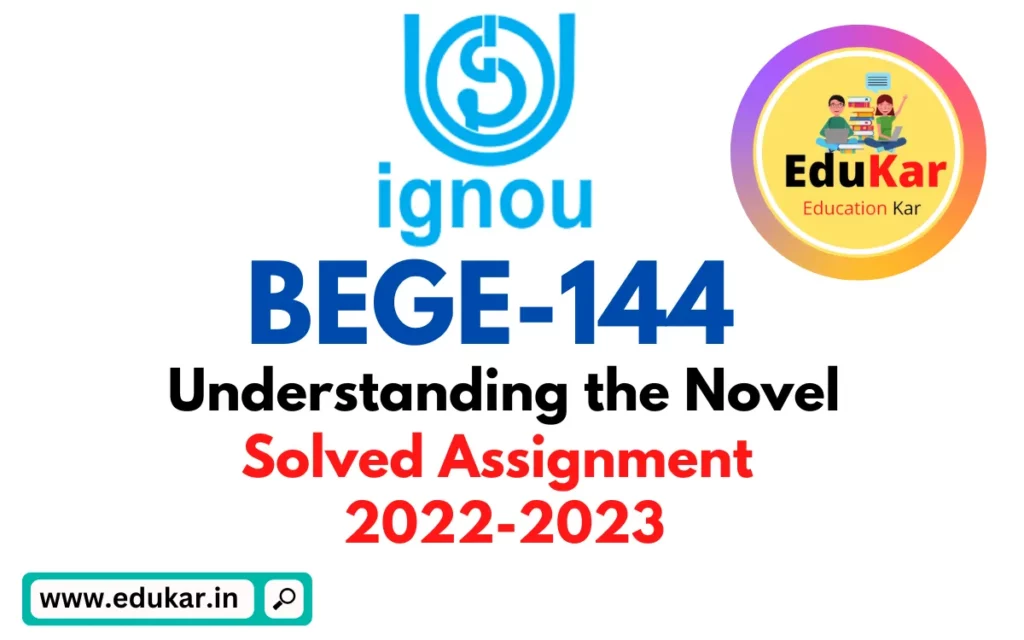Contents
- 1 Section A
- 2 Write short notes in about 100 words each: 4×5=20
- 3 (i) Narrative
- 4 (ii) New Trends in Fiction Writing
- 5 (iv) Characterisation
- 6 (iv) Theme
- 7 Section B
- 8 Answer the following in about 350 words each: 4X20=80
- 9 1. Examine the similarities/ points of contrast between Kate Chopin and Edna Pontellier in The Awakening.
- 10 2. Do you think that Things Fall Apart also appeals to readers across national boundaries? Give reasons in support of your answer.
- 11 3. Write a critical note on the significance of songs in Paraja.
- 12 4. Would you agree that Things Fall Apart is just a simple story of the rise and fall of one man? Give reasons for your answer.

| Title | BEGE-144 |
| University | IGNOU |
| Degree | Bachelor Degree Programme |
| Course Code | BEGE-144 |
| Course Name | Understanding the Novel |
| Programme Name | Bachelor of Arts (General) |
| Programme Code | BAG |
| Total Marks | 100 |
| Year | 2022-2023 |
| Language | English |
| Last Date for Submission of Assignment: | For June Examination: 31st April For December Examination: 30th September |

Section A
Write short notes in about 100 words each: 4×5=20
(i) Narrative
Ans: Narrative refers to a story, either fictional or real, that is communicated to an audience. It often includes characters, setting, plot, and themes and can be delivered in various forms including written, spoken, or visual. The purpose of a narrative is to entertain, educate, or convey information, and can take many forms, including novels, short stories, films, and plays. Effective narratives engage the audience and transport them into the story, allowing them to experience the events and emotions being depicted. In literature, narrative structure refers to the way the story is organized, including the plot and its elements.
(ii) New Trends in Fiction Writing
Ans: Fiction writing is constantly evolving and new trends emerge over time. In recent years, there has been a shift towards more inclusive and diverse representation in fiction. This includes stories and characters from a range of cultural, ethnic, and gender identities. Another trend is the blurring of genre boundaries, with writers experimenting with elements from different genres such as science fiction, romance, and fantasy.
There is also a growing interest in self-referential and metafictional writing, where the author comments on the act of storytelling itself. Additionally, the rise of digital technologies has led to the emergence of new forms of fiction, such as interactive and immersive storytelling experiences. Finally, there has been a renewed focus on literary writing, with a renewed appreciation for literary craftsmanship and the art of writing. These new trends in fiction writing reflect the changing tastes and perspectives of readers and a desire for fresh, innovative storytelling experiences.
(iv) Characterisation
Ans: Characterization is the process of creating and developing characters in fiction. A well-crafted character is the foundation of a good story, and can make the story relatable, engaging, and memorable to the reader. There are several ways to characterize a character, including physical description, dialogue, actions, thoughts and emotions, and their relationships with other characters.
A character’s personality and behavior, along with their motivations and conflicts, are essential in making them feel like real, multi-dimensional people. Characterization can be direct, where the author explicitly describes a character’s traits, or indirect, where the character’s personality is revealed through their actions and interactions.
Effective characterization involves a combination of these techniques and can greatly impact the reader’s experience of the story. Well-developed characters can help advance the plot, create tension and conflict, and evoke emotions in the reader. In turn, memorable characters can also contribute to the overall impact and success of the story.
(iv) Theme
Ans: A theme is a central idea or message that runs throughout a piece of fiction. It is the overarching meaning or significance that the author is trying to convey to the reader. Themes can be universal, such as love, death, or the meaning of life, or more specific to a particular story, such as the corrupting influence of power.
The theme is often not explicitly stated in the story, but is instead revealed through the characters, events, and symbols. It is up to the reader to interpret the theme based on their understanding of the story.
The theme can shape the entire story, influencing the characters, events, and tone. It can also serve as a lens through which the reader can understand and interpret the story. A strong theme can elevate a story, giving it deeper meaning and resonating with the reader on a personal level. In addition, themes can also be used to comment on larger societal or cultural issues, making a story more thought-provoking and impactful.
Section B
Answer the following in about 350 words each: 4X20=80
1. Examine the similarities/ points of contrast between Kate Chopin and Edna Pontellier in The Awakening.
Ans: Kate Chopin and Edna Pontellier, the author and main character of The Awakening, respectively, share some similarities in their lives and experiences, as well as some contrasts.
One of the similarities between the two is that they were both women living in a patriarchal society in the late 19th century. Kate Chopin was born in St. Louis in 1850 and was married to a wealthy businessman, while Edna Pontellier was a Creole wife and mother living in New Orleans. Both women were constrained by the societal norms and expectations of their time and faced limited opportunities for self-expression and fulfillment.
Another similarity between them is their passion for self-discovery and their desire for personal freedom. In The Awakening, Edna embarks on a journey of self-discovery, seeking to break free from the constraints of her role as a wife and mother. Similarly, Kate Chopin was a feminist and a free spirit, who sought to challenge the conventional norms of her time through her writing.
However, there are also some points of contrast between Kate Chopin and Edna Pontellier. One major difference is that while Edna Pontellier is portrayed as a woman struggling to assert her individuality and independence in a restrictive society, Kate Chopin was able to live a more liberated life. Chopin was a writer, an intellectual, and a member of the St. Louis literary scene, while Edna’s attempts to assert her independence are often met with resistance and are ultimately unsuccessful.
Another contrast is in their respective experiences with motherhood. Edna Pontellier is portrayed as a conflicted and ambivalent mother, who feels trapped and suffocated by her role as a mother, while Kate Chopin was a devoted mother of six children.
2. Do you think that Things Fall Apart also appeals to readers across national boundaries? Give reasons in support of your answer.
Ans: Yes, I do think that Things Fall Apart appeals to readers across national boundaries. There are several reasons for this:
- Universality of themes: The novel deals with themes that are universal and timeless, such as the loss of cultural identity, the impact of colonialism, and the struggle for power and control. These themes are relevant to people across different cultures and nations, and resonate with readers regardless of their background.
- Cultural richness: Things Fall Apart is set in pre-colonial Africa and provides a rich and nuanced portrayal of African culture, traditions, and values. This cultural richness appeals to readers across national boundaries who are interested in learning about different cultures and ways of life.
- Complex characters: The novel features complex characters with distinct personalities and motivations, which makes them relatable and memorable to readers. This ability to create relatable and memorable characters contributes to the novel’s appeal across national boundaries.
- Style of writing: The author, Chinua Achebe, uses a clear and straightforward writing style that is accessible and engaging for readers. The language used in the novel is easy to understand, yet rich in detail and imagery, which makes it appealing to readers from different backgrounds.
- Historical significance: Things Fall Apart is a historical novel that sheds light on the impact of colonialism on African societies, and is widely considered as a classic of African literature. This historical significance and its recognition as a classic make it appealing to readers across national boundaries who are interested in the history and cultural heritage of Africa.
3. Write a critical note on the significance of songs in Paraja.
Ans: Songs play a significant role in R.K. Narayan’s novel “Paraja”. They are an integral part of the lives of the people in the novel, reflecting their culture, beliefs, and emotions. The songs in the novel serve several purposes:
- Cultural representation: The songs in “Paraja” are a window into the culture of the tribespeople, providing insight into their beliefs, traditions, and values. Through the songs, the reader is introduced to the rich cultural heritage of the tribespeople, which is otherwise not easily accessible.
- Emotional expression: The songs in the novel are used to express the emotions and feelings of the characters. They are a way for the characters to express their joy, sorrow, love, and longing, and to communicate their experiences and thoughts.
- Character development: The songs in the novel also play a role in character development, as they reveal the personalities and motivations of the characters. For example, the songs sung by the protagonist, Toru, reveal his internal struggles and his journey towards self-discovery.
- Thematic significance: The songs in “Paraja” also serve a thematic purpose, as they reflect the themes of identity, cultural heritage, and the struggle for survival that are central to the novel.
4. Would you agree that Things Fall Apart is just a simple story of the rise and fall of one man? Give reasons for your answer.
Ans: No, I would not agree that Things Fall Apart is just a simple story of the rise and fall of one man. While the protagonist, Okonkwo, plays a central role in the novel, the story is much more complex and encompasses a wide range of themes and issues. The following reasons support this argument:
- Themes of cultural identity: The novel explores the theme of cultural identity and the impact of colonialism on African societies. The story of Okonkwo is set against the backdrop of the changing cultural landscape of Nigeria, and the loss of traditional values and ways of life.
- The struggle for power and control: The novel also explores the struggle for power and control between different cultural groups, including the European colonizers and the African tribes. This struggle is a central theme in the novel, and is not limited to the story of Okonkwo, but extends to the entire community.
- Complex characters: The novel features a wide range of complex and nuanced characters, each with their own personalities, motivations, and experiences. The characters are not simply caricatures or stereotypes, but are fully developed and multi-dimensional, which adds depth and richness to the story.
- Themes of change and adaptation: The novel also explores the themes of change and adaptation, as the characters struggle to come to terms with the cultural, social, and political changes that are happening around them. This theme is not limited to the story of Okonkwo, but extends to the entire community.
How to Download BEGE-144 Solved Assignment?
You can download it from the www.edukar.in, they have a big database for all the IGNOU solved assignments.
Is the BEGE-144 Solved Assignment Free?
Yes this is absolutely free to download the solved assignment from www.edukar.in
What is the last submission date for BEGE-144 Assignment?
For June Examination: 31st April, For December Examination: 30th October
















